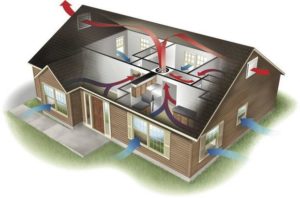 It is expected during summer that temperatures will go up, putting you against the odds of heated spaces. In this season, every homeowner makes frantic efforts to cool as much of their spaces as possible. One of the trickiest areas to cool is the upper floors. This is because as the air heats up from the lower levels, it rises to the upper chambers. Additionally, the heat gain that radiates down through the roof determines to greater extent the upstairs room temperatures.
It is expected during summer that temperatures will go up, putting you against the odds of heated spaces. In this season, every homeowner makes frantic efforts to cool as much of their spaces as possible. One of the trickiest areas to cool is the upper floors. This is because as the air heats up from the lower levels, it rises to the upper chambers. Additionally, the heat gain that radiates down through the roof determines to greater extent the upstairs room temperatures.
Any cold air conveyed upstairs via the ductwork almost immediately flows back down the stairwell and settles in the lower level of your home. There is always a temptation for homeowners to install separate AC units to take care of the heating upper spaces. However, this will be uneconomical and inefficient.
The solution to cooling your upper floors adequately is by increasing the flow of conditioned air to these rooms proportionately or alternatively reducing the perception of heat by enhancing circulation upstairs. The following solutions come in handy.
Zoning
Zoning systems make use of motorized dampers to isolate particular areas of your home such as downstairs and upstairs into independent cooling zones. The motorized dampers are usually installed in HVAC ducts and each zone has a dedicated thermostat.
In order to counteract natural heat gain, flow of cool conditioned air is maximized to the upstairs zone while the downstairs operate separately at its own thermostat setting.
Maintaining Return Airflow
If you are to maintain a balanced airflow and maximize your upstairs cooling, each room that has an AC supply duct must also have a separate and dedicated return duct. In most cases, a single central return duct located in a hallway usually accommodates the flow of return air from the supply ducts positioned in all upstairs rooms.
The challenge with this architecture is that keeping the air path from multiple supply ducts into the central return open is usually problematic because the bedroom doors are often closed for obvious privacy reasons. To deal with this, it is recommended that you install pass-through air grilles in jumper ducts between rooms in the ceiling so as to handle supply air flow to the central return duct. This preserves neutral air balance in every room and optimizes cooling conditions.
Boosting Cooling with Ceiling Fans
Ceiling fans may no longer be fashionable, but their utility is still relevant even in the 21st century. It can go a long way in helping you to condition the air in your upstairs rooms. The downward air circulation from these fans makes air-conditioned rooms feel much cooler than reflected on the thermometer.
When you run a ceiling fan, occupants of the particular room have a perception of coolness of up to 8 degrees lower than the reading of the thermometer. Because of this effect, the upstairs heat which is caused by rising hot air and attic heat gain is offset.
Try out the above solutions for a cooler upstairs.





 February 28th, 2018
February 28th, 2018  steve
steve  Posted in
Posted in 
